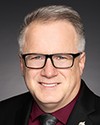Madam Speaker, today I rise to speak to a critical topic related not just to this place but also to indigenous people right across the country. I want to mention the fact that I will be splitting my time with the hon. member for Winnipeg Centre, who is very honourable. She is not only a champion for indigenous rights in this place but also a champion for indigenous people right across our planet.
We are prepared to discuss a topic presented to the indigenous and northern affairs committee related to the member for Edmonton Centre. The member for Edmonton Centre had falsely identified himself as indigenous, or at least misled individuals, in particular the Liberal Party of Canada, into believing this. For what purpose would one do this? Why would someone go through the process of undertaking identity fraud, identity theft, and taking from a people what is truly theirs and more? Actually, when I mentioned this story to my sister, she said something really interesting. She said, “Oh, great, someone wants to identify as indigenous. That is fantastic. They should also face the consequences we do.” Wow, members can imagine how my sister, a visible woman of colour, was not able to overcome the serious barriers that were present to her as a young person when trying to enter into business or jobs, when trying to enter into a workplace where she was seen as a whole person. The contrast that we are seeing today has been extraordinarily exerted in the past few years. Buffy Sainte-Marie is an example of what is a really real and unfortunate circumstance facing Canadians. This example was a wake-up call to Canadians, to each and every one of us.
This kind of pervasive fraud is often not prosecuted, not investigated. This raises the question of why a person does it, as well as why we do not investigate it. Canada had 1,100 companies that were just deregistered; they have been delisted from the federal indigenous procurement registry, something that was mentioned by the indigenous services minister a few weeks ago. Wow, 1,100 companies were pre-approved as indigenous for the purpose of procurement in the Government of Canada's indigenous procurement strategy. It is shameful that we were unable to designate and delist those companies beforehand. This policy has been in place since the nineties. My God, what a failure it is of both Conservative and Liberal governments that they had no care or concern about this issue for as long as this policy has been in existence.
Worse yet, the Conservatives now cry wolf as if they were big stalwarts or big champions of indigenous rights, indigenous identity, when they were the government in charge at the time this program had been operating. The Liberals inherited this problem, and they kept it. It is a matter of convenience, a marriage of convenience perhaps. This has played out in Canada's history for the better part of 157 years, often to the detriment of indigenous people.
There are consequences to this kind of misbehaviour, these kinds of crimes. We have seen in Nunavut, for example, a sentence of three years in prison in a case where two young people had taken indigenous identity, Inuit identity, for the purposes of educational funding. It is shameful. Now we see, in this great, august chamber, individuals who are unable to tell us who they truly are; they stand very proudly and profess who they are, without any ability to understand that there are qualifiers to understanding that. There are frameworks.
There are actually even court cases in Canada that indigenous people had to overcome to even see their own people identified and recognized. Regina v. Van der Peet, for example, is a first nations Supreme Court case that delineated who was first nations for the purpose of commercial rights. Indigenous Métis people have had to, still today, since 2003, in the Powley case, decide who is indigenous. In those cases, the court was deciding. How shameful is it that the government was so unable to create a nation-to-nation, government-to-government relationship with those it literally legislated for when it was part of their benefit? At the time of the Indian Act, for example, the government knew who was indigenous. It knew who was indigenous for the purposes of residential school or the sixties scoop. It knew who was indigenous when it came to paying out treaty breaches, massive breaches in the agreements made by our ancestors.
Government members knew who was indigenous then, but now, when they happen to be sitting in cabinet, all of a sudden, they do not. Holy smokes, they could not even ask the guy. They are going to put him in their indigenous caucus. They are going to label it as an indigenous caucus, and they will call it the “fantastic eleven”. Today, we have questions about those individuals. We have questions about those who pose as indigenous for prestige, reputation or access to funding. The reason this is an important investigation to undertake is that the pain is felt deeply.
I am sure some would argue, particularly the Liberals, that the real victim here is the member for Edmonton Centre. However, the real victims are indigenous people, indigenous businesses and indigenous communities. They have done the hard work of organizing their community, creating a benefit-impact study, talking to the community members, understanding what they can do as a community and creating employment, only to be met with a rigged system in Ottawa created by Liberals and Conservatives.
The Liberals and Conservatives like to talk a big game about how they are very different parties, but they have always benefited from being on the same side of the coin. When one does something bad, the other one is elected and then does the bad thing again. Always, over and over, this tradition exists in Canada. There are rights.










